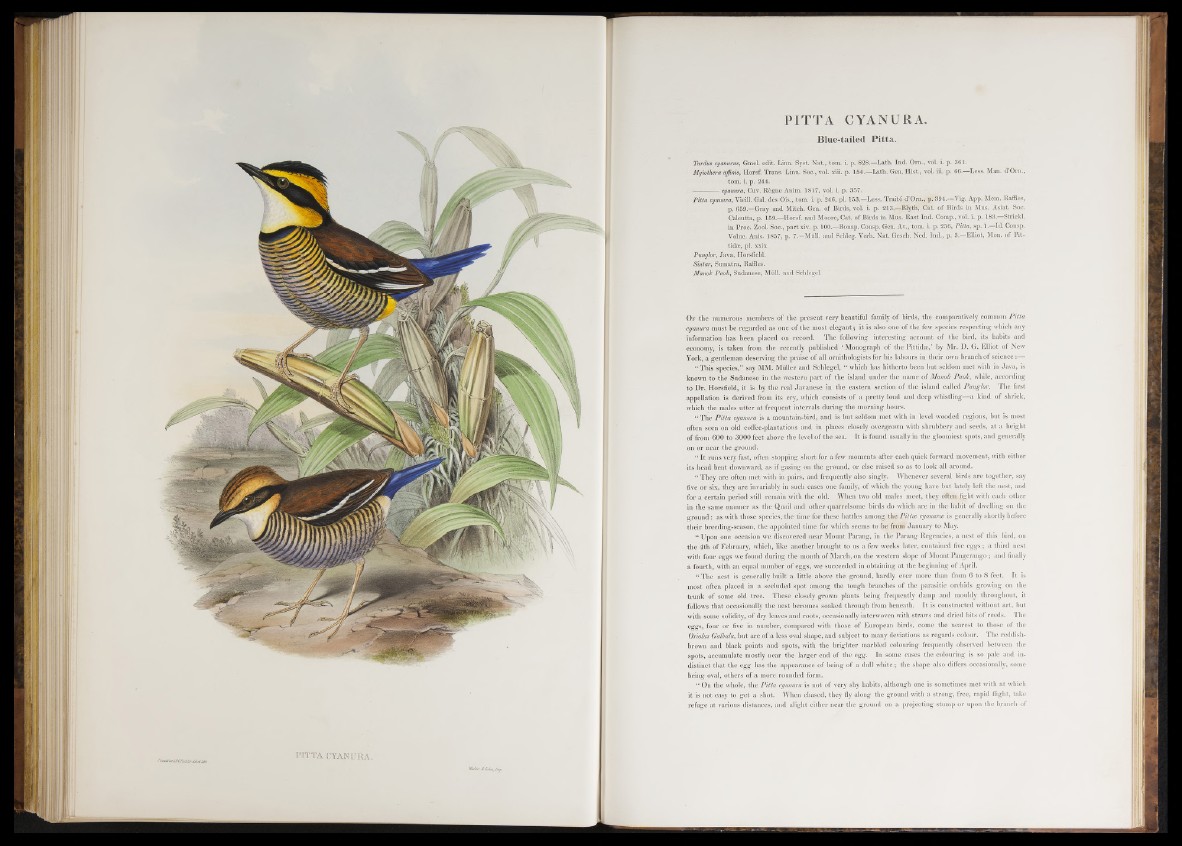
JCouUmdJ/CJiuAJa'.eU.tlùA
TV/Ultr J Co/in,/nyt.
PITTA CYANURA.
Blue-tailed P itta .
Turdus cyanurus, Gmel. edit. Linn. Syst. Na t., tom. i. p. 828.—Lath. Ind. Orn., vol. i. p. 361.
Myiothera affinis, Horsf. Trans. Linn. Sog., vol. xiii. p. 154.— Lath. Gen. Hist., vol. iii. p. 66.—Less. Man. d’Orn.,
tom. i. p. -244.
--------------cyanura, Cuv. Règne Anim. 1817, völy i. p. 357.
Pitta cyanura, Vieill. Gal. dés Ois., tom. i. p. 246, pl. 153.—Less. Tra ité d’O rn., p . 394.—Vig. App. Mem. Raffles,
p. 659.—Gray and Mitch, Gem. o f Birds, vol. i. p. 213.—Blyth; Cat. o f Birds in Mus. Asiat. Soc.
Calcutta, p. 1 5 9—H o r s f and Moore, Cat. of B irds in Mus. E ast Ind. Comp., vol. i. p. 183.—Strickl.
in Proc. Zool. Soc., p a r t xiv. p. 100.—Bonap. Consp, Gen. Av., tom. i. p. 256, Pitta, sp. 1.—Id. Consp.
Voluc. Anis. 1857, p. 7 .-M ü l l , and Schleg. Yerh. Na t. Gesch. Ned. In d ., p . 3.—Elliot, Mon. o f Pit-
tidîe, pi. xxix.
Punglor, Java, Horsfield.
Sintar, Sumatra, Raffles.
Manok Paofc, Sudanese, Müll, and Schlegel.
O f the numerous members of the present very beautiful family of birds, the comparatively common Pitta
cyanura must b e regarded as one of the most elegant; it is also one o f the few species respecting which any
information has been placed on record. The following interesting account of the bird, its habits and
economy, is taken from the recently published ‘ M onograph of the Pittidae,’ by Mr. D. G. Elliot of New
York, a gentleman deserving the praise of all ornithologists for his labours in their own branch of science :—
“ This species,” say MM. Muller and Schlegel, “ which has hitherto been but seldom met with in Java, is
known to the Sudanese in the western p art of the island under the name of Manok Paolc, while, according
to Dr.. Horsfield, it is by the real Javanese in the eastern section of the island called Punglor. The first
appellation is derived from its cry, which consists of a pretty loud and deep whistling—a kind of shriek,
which the males utter a t frequent intervals during the morning hours.
“ The Pitta cyanura is a mountain-bird, and is but seldom met with in level wooded regions, but is most
often seen on old coffee-plautations and in places closely overgrown with shrubbery and seeds, at a height
of from 600 to 3000 feet above the level o f the sea. I t is found usually in the gloomiest spots, and generally
on or near the ground.
“ It runs very fast, often stopping short for a few moments after each quick forward movement, with either
its head bent downward, as if gazing on the ground, or else raised so as to look all around.
“ They are often met with in pairs, and frequently also singly. Whenever several birds are together, say
five or six, they are invariably in such cases one family, of which the young have but lately left the nest, and
for a certain period still remain with the old. When two old males meet, they often fight with each other
in the same manner as the Quail and other quarrelsome birds do which are in the liabit of dwelling on the
gro u n d : as with those species, the time for these battles among the Pittoe cyanuroe is generally shortly before
their breeding-season, the appointed time for which seems to be from January to May.
“ Upon one occasion we discovered near Mount Parang, in the Parang Regencies, a nest of this bird, on
the 4th of February, which, like another brought to us a few weeks later, contained five eg g s; a third nest
with four eggs we found during the month of March, on the western slope of Mount Pangerango; and finally
a fourth, with an equal number o f eggs, we succeeded in obtaining a t the beginning of April.
“ The nest is generally built a little above the ground, hardly ever more than from 6 to 8 feet. I t is
most often placed in a secluded spot among the tough branches of the parasitic orchids growing on the
trunk of some old tree. These closely grown plants being frequently damp and mouldy throughout, it
follows that occasionally the nest becomes soaked through from beneath. I t is constructed without art, but
with some solidity, of dry leaves and roots, occasionally interwoven with straws and dried bits of reeds. The
eggs, four or five in number, compared with those of European birds, come the nearest to those o f the
Oriolus Galbula, but are of a less oval shape, and subject to many deviations as regards colour. The reddish-
brown and black points and spots, with the brighter marbled colouring frequently observed between the
spots, accumulate mostly near the larger end of the egg. In some cases the colouring is so pale and indistinct
that the egg has the appearance of being of a dull white; the shape also differs occasionally, some
being oval, others o f a more rounded form.
“ On the whole, the Pitta cyanura is not of very shy habits, although one is sometimes met with at which
it is not easy to get a shot. When chased, they fly along the ground with a strong, free, rapid flight, take
refuge at various distances, and alight either near the ground on a projecting stump or upon the branch of